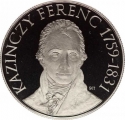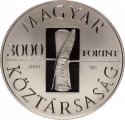You are about to finish your registration. Please check your mailbox (including spam folder). There should be a letter with a confirmation link. Check setting to make sure that your e-mail address is correct.
Send letter againDescription
Ferenc Kazinczy (1759-1831) was a prominent Hungarian figure, renowned as an author, poet, translator, and linguist, often hailed as the "reformer" of the Hungarian language.
Kazinczy played a pivotal role in the Hungarian language reform movement of the late 18th and early 19th centuries. He championed the purification and modernization of Hungarian, advocating for the integration of vernacular expressions while advocating the removal of outdated and foreign terms. His objective was to cultivate a more vibrant and coherent literary language for Hungarian literature.
As a prolific writer and translator, Kazinczy made significant contributions to Hungarian literature and culture. He composed poetry, essays, and letters, and translated numerous literary works into Hungarian, including pieces by Shakespeare and Goethe.
Among Kazinczy's most remarkable achievements was his leadership in compiling the "Kazinczy Dictionary," a comprehensive reference of the Hungarian language aimed at establishing standardized vocabulary and spelling. His endeavors laid the groundwork for contemporary Hungarian linguistic standards, leaving a profound and enduring impact on Hungarian literature and cultural heritage.
Engraver: Enikő Szöllőssy
Obverse

|
Depicts the portrait of Ferenc Kazinczy. The portrait is based on the copperplate engraving by J.V. Kiminger. To the right of it, in three horizontal rows, Ferenc Kazinczy's signature, as well as the birth and death years "1759-1831," are visible. Along the edge, in the lower right corner, the engraver's privy mark is located. Kazinczy Ferenc |
|---|---|
Reverse

|
Depicts the neoclassical building of the Kazinczy Memorial Hall in Széphalom. In four horizontal rows beneath the depiction of the memorial hall, the inscription "Széphalom," the denomination, the inscription "FORINT," and the year of issue "2009" are visible. On the right side, the mint mark "BP." can be read. In the upper circular inscription, the text "HUNGARIAN REPUBLIC" is visible. MAGYAR KÖZTÁRSASÁG |
| Edge |



